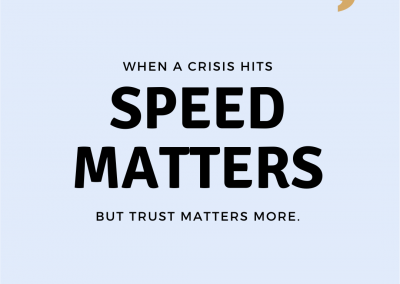In an ideal world, your company would receive nothing but wall-to-wall praise, glorious reviews, and critical acclaim. But the reality is that even the best brands receive negative press from time to time, from bad reviews to executive scandals. Mistakes happen, and no matter how hard you try, you never know when the next crisis is coming.
Take the recent and still running case of Nemlig.com for example. No need to comment on what everyone can see – their crisis communication seems unplanned – or to put it straight, out of control. Could they have planned for this beforehand? Yes, of course. The problems have even been in the media earlier, but apparently that wasn’t enough for them to prepare for the next coming crisis.
With that in mind, it’s important to always plan for the worst. Preparing for the storm before it hits will help mitigate potential damage to your reputation. There are plenty of steps to take to deal with a crisis quickly and effectively, and we’ve outlined some of the most important.
1. Identify potential risks: some crises come from the blue, but others you might see coming. Construction companies always run the risk of injuries to workers, while companies importing products from abroad might discover poor working conditions in factories. Monitoring and preventing these issues is step one, but it’s also wise to prepare a communications template for a quick response.
2. Prepare response team: In a crisis, it’s important to act fast and speak clearly on the company’s behalf. Having a dedicated team ready to kick into action will save time, and prevent multiple voices clouding the message. The best response teams combine in-house professionals, who have a working knowledge of the organisation, with PR experts who can empathise with the journalistic perspective.
3. Craft your message: Decide what the company’s position on the issue is, and how you will respond. It’s crucial to be seen as open and transparent: address the situation and what the company will do about it. If a mistake has been made, the sooner you acknowledge it, the sooner people move on. If the story is unjustified, don’t rush into reactive statements but measure a response that acknowledges the issue without pointing fingers elsewhere.
4. Address your consumers: The long-term consequence of PR crises can be consumers’ loss of faith in your brand. Addressing them directly via social media or self-published statements is the best way to communicate your message directly, and regain their trust, rather than leaving them to piece the story together through media reports.
5. Monitor the situation: In the days and weeks after a PR crisis, it’s crucial to monitor the conversation around the issue. Check search engine results pages to make sure your version of events is being heard, and respond to public comments on social media to ensure false information isn’t circulating.
6. Shift the conversation: After a negative story, the best way to recover credibility for your brand is to create positive coverage. Don’t shy away from the press, but make sure the next time people hear your name it’s for the right reasons!
6. Learn from the situation: Mistakes happen, but if you can learn from them then something positive can be drawn from the crisis. Analyse how staff and management responded, and discuss what could be done differently next time.
Here at Think PR we are experts in crisis management, and can create tailor-made action plans for your brand, to make sure you’re not caught short and unprepared for bad publicity. Remember, a little forward thinking now could save your reputation in the future!





0 Comments